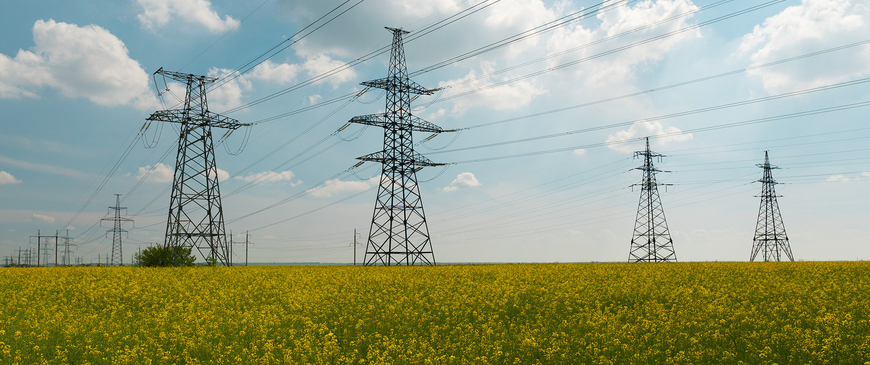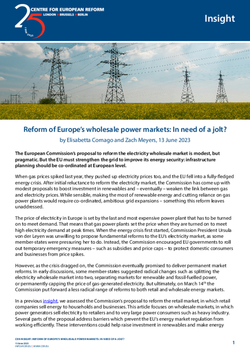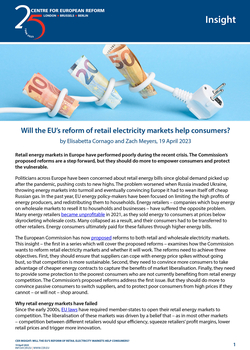
Reform of Europe's wholesale power markets: In need of a jolt?
The European Commission’s proposal to reform the electricity wholesale market is modest, but pragmatic. But the EU must strengthen the grid to improve its energy security: infrastructure planning should be co-ordinated at European level.
When gas prices spiked last year, they pushed up electricity prices too, and the EU fell into a fully-fledged energy crisis. After initial reluctance to reform the electricity market, the Commission has come up with modest proposals to boost investment in renewables and – eventually – weaken the link between gas and electricity prices. While sensible, making the most of renewable energy and cutting reliance on gas power plants would require co-ordinated, ambitious grid expansions – something this reform leaves unaddressed.
The price of electricity in Europe is set by the last and most expensive power plant that has to be turned on to meet demand. That means that gas power plants set the price when they are turned on to meet high electricity demand at peak times. When the energy crisis first started, Commission President Ursula von der Leyen was unwilling to propose fundamental reforms to the EU’s electricity market, as some member-states were pressuring her to do. Instead, the Commission encouraged EU governments to roll out temporary emergency measures – such as subsidies and price caps – to protect domestic consumers and businesses from price spikes.
However, as the crisis dragged on, the Commission eventually promised to deliver permanent market reforms. In early discussions, some member-states suggested radical changes such as splitting the electricity wholesale market into two, separating markets for renewable and fossil-fuelled power, or permanently capping the price of gas-generated electricity. But ultimately, on March 14th the Commission put forward a less radical range of reforms to both retail and wholesale energy markets.
In a previous insight, we assessed the Commission’s proposal to reform the retail market, in which retail companies sell energy to households and businesses. This article focuses on wholesale markets, in which power generators sell electricity to retailers and to very large power consumers such as heavy industry. Several parts of the proposal address barriers which prevent the EU’s energy market regulation from working efficiently. These interventions could help raise investment in renewables and make energy prices lower and less volatile. But other non-market barriers, which the reform does not tackle, risk slowing down energy investment.
Wholesale power markets today
Europe’s wholesale electricity markets hinge on the ‘clearing price’, at which enough energy is sold to meet demand. All energy producers are paid the same clearing price, so that energy that is cheaper to produce earns greater profits. The clearing price is often set by gas plants, which can be turned on and off on demand. However, after Russia’s invasion of Ukraine, Europe is less willing to rely on gas as a ‘bridging’ energy source on the way to the full decarbonisation of its electricity production.
After Russia’s invasion of Ukraine, Europe is less willing to rely on gas as a ‘bridging’ energy source on the way to the full decarbonisation of its electricity production.
The fact that gas sets the clearing price means that lower-cost energy sources should in theory have enjoyed high profits. This would have sent efficient price signals to investors – rewarding them for investing in the lowest-cost forms of energy production, and encouraging more green energy generation. Not all energy producers have been lining their pockets with large returns like their colleagues in the oil and gas sector, however. Energy producers’ profits have varied depending on their energy source and when they sold their energy.
Lower-cost generators, such as hydroelectric, nuclear, solar and wind power plants, enjoyed high profits at the beginning of the energy crisis. But in September 2022 the EU required national governments to cap the ‘excess’ revenues of non-gas energy producers and use those revenues to protect consumers from energy price hikes.
The EU’s shift away from market mechanisms was a risky move. The Commission and member-states hoped that by temporarily taking a share of the high profits of energy companies, they could help to pay for measures like price caps and subsidies to consumers. This measure allowed member-states to set their own revenue caps as long as they respected a common upper bound, meaning that electricity producers in different countries were now facing different constraints on their revenues and profits, fragmenting the EU energy market.
In addition, revenue caps on lower-cost electricity generators risked hurting incentives to invest in clean energy just as governments need to encourage much more investment in this area. Although green energy sources remained profitable, because they enjoyed the high clearing price set by gas, investors’ confidence has not been helped by the EU’s radical changes to market rules in response to political pressure.
The business case for building new power plants is complicated by price volatility. To mitigate the risk of price volatility and get more stable and predictable profits, energy producers can sell more energy on long-term wholesale markets ahead of time, and less at the last moment before it is needed (on the so-called spot market). Energy producers who sold ahead of time missed out on potentially huge profits when spot markets peaked in 2022. However, their more stable and predictable profits still proved sufficient to justify their investments.
The drivers of price volatility will change as renewables become ever more present in the EU power mix: volatility due to energy intermittency – and our capacity to mitigate it – will be more important than fossil fuel prices.
Wholesale energy prices have now collapsed and are much closer to their pre-crisis levels, while their trajectory in the medium term is uncertain. Investment in power generation generally requires large amounts of up-front capital and long-term certainty about prices. Investors want to hedge against price risks, but while wholesale energy markets offer enough one- to three-year contracts to meet their demand, there are not as many options over longer periods. Furthermore, as the era of low interest rates ends, capital-intensive energy investments find themselves facing higher borrowing costs – making the long-term certainty of returns even more important.
The Commission's proposals
The Commission’s reform proposal is rightly modest, because the EU’s energy market regulation weathered the crisis, and it seeks to strengthen the growth of renewables. The proposal includes three main changes: promoting the use of long-term contracts, facilitating more options for electricity price hedging, and adding more flexible ways to balance supply and demand. All these changes should help reduce the role of gas in settling electricity prices, by boosting investment in renewables and in non-fossil technologies to match electricity demand and supply.
First, the proposal aims to provide long-term contracts that guarantee renewable energy producers certain prices over a set period, in order to boost investment in clean electricity. The focus is on two kinds of contracts. There are contracts between government entities and renewable power producers – so-called two-sided contracts for difference, or CfDs. Two-sided CfDs guarantee renewable energy generators a certain price, meaning the government will pay them the difference if the market price dips below it – but conversely, the public budget will benefit from ‘windfalls’ if market prices rise higher than the guaranteed price. And there are commercial contracts between private businesses and renewable power producers – called power purchase agreements, or PPAs. Both kinds of contracts can help producers hedge against changes in prices. By fixing prices and supply volumes, long-term contracts boost the business case for investment in renewables by reducing risk. With PPAs, buyers of wholesale electricity lose if the market price falls below the contracted price (while the renewable energy generator loses if the market price is higher).
As the role of renewables in Europe’s power mix increases, the drivers of price volatility will change: volatility due to energy intermittency (and our capacity to mitigate it) will be more important than fossil fuel prices. More renewables in the electricity mix should also reduce power prices in the medium to long run, because renewable power plants have lower operating costs than fossil fuel plants. The IEA calculates that renewables installed between 2021 and 2023 in Europe reduced wholesale power prices by 8 per cent.
Yet the use of long-term contracts, commercial or public, varies greatly across EU member-states. In Germany and the Netherlands all wind and solar capacity installed in 2021 was supported by public schemes, whereas that was the case only for a minor share in Poland, Denmark, Italy or Spain. Renewable energy investments backed by PPAs have grown in the past ten years, but overall in 2021, fewer than 30 GW of renewable energy capacity installations were PPA-backed – out of total added renewables capacity of over 80 GW.
There are two reasons for this. One is that PPAs are complex, so they have largely been used by big energy-intensive businesses rather than smaller businesses. The second is that not all national governments have taken the same steps to support PPAs. The Commission’s proposal encourages governments to provide guarantees to help parties interested in PPAs hedge against the default risk on their contract. This sensible reform is consistent with the market-driven philosophy of the existing regulatory regime and ought to help drive more investment in green energy generation. But it is unclear whether PPAs will become any more accessible for smaller businesses, which have been hit hardest by the energy crisis and which lack the expertise on how to navigate a complex energy market.
The second set of reforms is focused on helping energy forward markets work more efficiently. On forward markets, power generators sell their electricity from two days before delivery to many years beforehand. At present forward markets are largely organised on a national basis. Small, national markets are less liquid than multinational ones would be, which means that it is hard for wholesale energy buyers to find the right sellers, and keeps prices higher than they could be. More consolidated markets would increase the number of buyers and sellers, so market participants could pay lower prices for the same products. This would make forward markets a better tool for producers and consumers to hedge against power price risks. To address the fact that forward markets need more European consolidation, the Commission wants to combine neighbouring forward markets into ‘regional virtual hubs’.
The Commission’s proposals in this area should encourage more renewables to be deployed, which will eventually reduce prices. However, renewables cannot efficiently meet all demand yet, because they cannot easily scale up and down as energy demand fluctuates. To reduce the need for gas power plants (and fossil fuelled power plants more generally) to help with intermittency, we need more use of so-called non-fossil flexibility sources. Flexibility sources are technologies allowing variable, fluctuating electricity demand and supply to always match. Gas power plants can meet this need by quickly ramping up generation when demand is high. Non-fossil flexibility sources aim to do the same, without burning fossil fuels. These technologies include batteries to store excess renewable energy produced when supply is higher than demand until it is needed, and mechanisms encouraging energy users to reduce consumption when demand is peaking (‘demand response’ mechanisms).
The third set of Commission proposals aims to support these types of flexibility sources. This would ensure that gas power plants were not called upon as frequently, reducing the number of times in which they set the power price. The Commission wants to require national energy regulators to assess and report regularly on the need for other flexible energy technologies in their country’s power system, and governments to set indicative targets for their deployment. The importance of flexibility will grow with the need to balance out the intermittency of renewables, as the latter take an ever-greater share of the energy mix. Indicative targets for the use of non-fossil flexibility sources can contribute to raising regulators’ and governments’ awareness of the importance of these technologies in the energy system.
But regulators’ reports and government targets alone will not boost the deployment of clean flexibility options. Incentives for non-fossil flexibility would help ensure that smaller-scale green tech is not penalised relative lo large-scale gas-fuelled power plants in flexibility supply. The Commission proposal encourages governments to adjust their capacity mechanisms – markets that pay legacy fossil power plants for their flexibility services – to also pay for non-fossil flexibility. Where capacity mechanisms do not exist, governments should set up adequate support schemes: the Commission provides a range of sensible guidelines for the design of such support schemes. But ultimately, the design of these schemes is what will really drive their effectiveness, and that is the responsibility of member-states.
Non-market barriers continue to make investment in renewables more difficult than it should be. One problem is the administrative complexity of obtaining permits for renewables installations. Last year’s REpowerEU package, a set of reforms to cut Russian gas out of the European market, should help here, by encouraging member-states to simplify and accelerate the process of issuing renewables permits.
A separate problem is due to infrastructure: EU member-states’ electricity grids were not designed for high investment in renewables and flexibility solutions. These solutions will change the patterns of electricity flows – for example, there will be fewer large power plants and more widely distributed small energy producers. Adapting to these changes will require massive investment in distribution and transmission infrastructure, within and across countries in the EU energy market. Without adapting the grid, investment in renewables cannot efficiently match demand across Europe. Yet national regulators who supervise grid operators’ investments and profits have traditionally focused more on keeping costs down, giving grid operators few incentives to make new investments. This risks holding back the green transition. Given the role that cross-border electricity trade will play in the efficiency and security of the European energy system, it is surprising that the Commission proposals do little to confront this problem.
The next Commission should consider new governance models for grid planning and new market design solutions to ensure that investments in the grid across Europe scale up together with new renewable energy generation. There will have to be greater co-ordination between EU member-states as well as with neighbours in planning grid expansions. Co-operation with the UK and Norway will be needed to expand the grid in line with the ambitious North Sea offshore wind developments. That will ensure that the total investment costs of the energy transition are minimised, by locating renewables and grids in the most efficient places. The Commission should also introduce tools to allow the electricity price to better reflect congestion on the grid, to incentivise investments that can reduce congestion. So-called nodal pricing is one such tool, whereby the wholesale power price would vary at each node of the European power grid, in a much more granular way than in the current system.
The next Commission should consider greater EU-level grid planning and new market design solutions to ensure that investments in the grid across Europe scale up together with new renewable energy generation.
Conclusion
The EU’s regulation of wholesale energy markets – and its reliance on market mechanisms to deliver efficient outcomes – helped make Europe’s recent energy crunch less severe than it might otherwise have been. Even so, as a result of the high bills faced by households and industry, the European Commission is under significant political pressure to reform the system radically. The Commission’s proposals for reform are modest but pragmatic.
But more needs to be done to facilitate the energy transition and ensure that a net-zero power system also makes energy more affordable. Investments to expand the power grid, both within and across countries through interconnectors, need to go hand in hand with the deployment of renewables and flexibility sources, to reduce the role of fossil fuels in electricity markets. This will require more concerted efforts to co-ordinate infrastructure planning at the European level, including with the EU’s neighbours.
Elisabetta Cornago and Zach Meyers are senior research fellows at the Centre for European Reform.



Add new comment